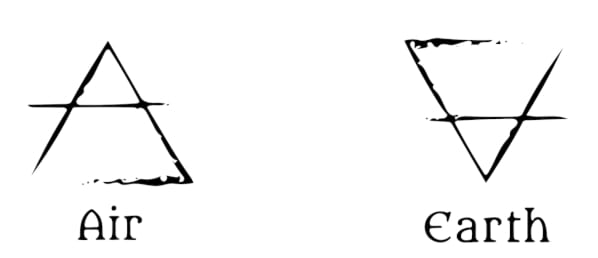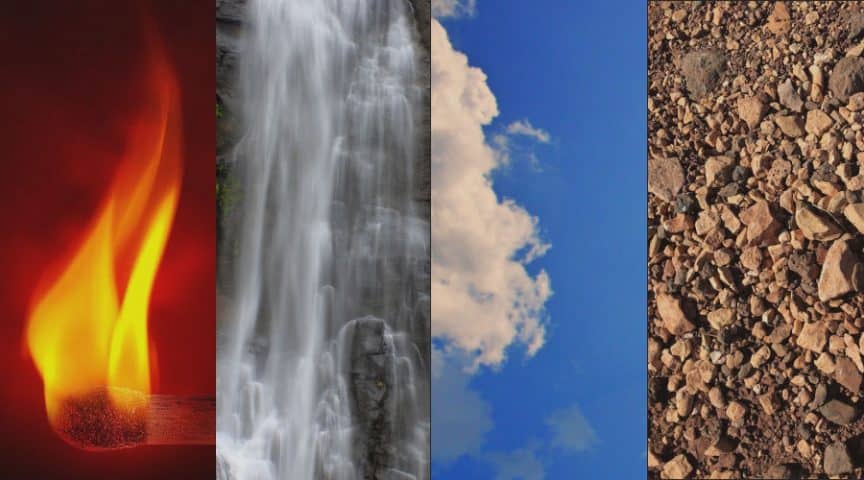The four elements are comprised of four different earthly energies that have been worked within a variety of spiritual, esoteric, and mystical practices since ancient times. Occurring throughout many cultures simultaneously, these elements were primarily brought to countenance in ancient Greece.
Though in modern times some subscribe to more elements than these four alone, this quartet was considered by the ancients, and by a majority of practitioners still, to be the sustaining energies of life itself. The four elements consist of:
- Earth
- Fire
- Air
- and Water
As it is thought that the universe is made up of these four elements, along with a 5th element which we will discuss momentarily, it is believed that human beings themselves are composed and managed by these elements. The physical world was calculated in ancient times to be comprised of the four corporeal traits consisting of:
- Hot
- Cold
- Dry
- and Moist
Combining hot and dry results in fire, combining hot and wet produces air, dry and cold bring about Earth and cold and wet result in water. It is believed that through the combination of these four elements that the physical realm is constructed, and along with the fifth element that life itself is brought about.
A Word on the Fifth Element
The fifth element was introduced to popularity by the prominent philosopher Aristotle and known to him and his contemporaries as aether.
However, the 5th element has been known by many names throughout time and place such as in Europe where it is referred to as quintessence, or India where it is known as akasha.
This element has also been known as the void by Japanese swordsman saint Miyomoto Musashi, Prana in Yoganic traditions, and more recently, as simply, the spirit. Regardless of the name given, ultimately, what we will refer to here as spirit, has the same connotations through many cultures.
The fifth element, or spirit, is seen as an eternal celestial life force that fills all space and time and is the energy responsible for animating life throughout the universe. In the Greek tradition, from which the popular notion of the four elements is derived, the spirit realm was seen as being on a higher plane than that of the earthly one.
Essentially, across the many cultural traditions of magick and esoteric workings, the spiritual element does not necessarily follow any of the standard rules by which the other four elements are controlled, and is considered the glue, or fabric, from which the cosmos is held together and the workings of the God’s are cemented.
Check out our recommendations at “Occult Bookshelf” and many free resources at our “Free Library“

The Four Elements in Esoteric Tradition
Ultimately, the symbolism associated with the four elements, in the esoteric traditions, is the culmination of thousands of years of spiritual practice incorporating these archetypal energies into rituals, spells, and deity worship.
It is believed in multiple esoteric traditions that by better understanding these energies, we thereby gain an understanding of each element’s effects and combinations that affect our individual personalities, and we can then begin to attune ourselves with both our physical and spiritual plane.
Representing the human nature symbolically throughout esoteric practice, the elements are represented in such divination tools as the Τarot, and are believed to be channeled and called upon by certain crystals and stones.
Earth
Represented in many traditions as the most stable of the elements, the earth element is held as a symbol of stability, groundedness, nourishment, physical abundance, and dependability.
- Tarot Association: The Suit of Pentacles
- Crystal Association: Jade, Emerald, Peridot, Onyx
Air
The air element is considered to be the breath of life. The air element is seen as a symbol of communication, learning, thinking, and overall harmony. This being said, the air sign, being the force of life and change, can also bring about destruction.
- Tarot Association: The Suit of Swords
- Crystal Association: Picture Jasper, Blue Calcite, Citrine, Yellow Jasper
Fire
Considered throughout tradition to be one of the first elements upon the birth of the universe, fire is often considered a symbol for strength, passion, courage, and energy itself. The fire provides warmth and allows for life.
- Tarot Association: Suit of Wands
- Crystal Association: Amber, Sunstone, Ruby, Red Tourmaline
Water
Water is representative of the forever changing nature of the universe at large and is often times employed as a metaphor for the cycle of birth, death, and rebirth. Like the other elements, though water nourishes and nurtures, it too can be destructive.
- Tarot Association: The Suit of Cups
- Crystal Association: Amethyst, Aquamarine, Mother-of-Pearl, Celestite
Spirit
The spirit represents the spirit, mind, and heart of the individual, as well as that of the collective unconscious. The spirit element in many practices represents the archetypes of luck, emotion, fate, and the will of the Gods.
- Tarot Association: The Major Arcana
- Crystal Association: Howlite, Turquoise, Malachite, Clear Quartz
Check out our collection of “Free Online Audiobooks” and many free resources in our “Free Library”

The Four Elements in Magick
In many multitudes of magickal practices, the elements are powerful energies and forces to be employed for spell work, communication with deities, and protection.
Throughout many traditions when crafting the alter for spell work it is suggested that it contain the pentacle for the earth element, the wand to represent the fire element, the dagger to represent the air element, and the chalice or goblet to represent the water element.
Of course, in the practices of many, the elements are called upon when casting a circle for the initiation of spirit or spell work and each is considered a powerful energy to be independently used and combined with the others for further advancement into the mystical arts.
Earth
Earth is representative of the physical plane and is symbolic of all that is tangible. In spell work, it is considered useful for stabilizing, solidifying, and reinforcing. The element is employed in such matters as wealth or job attraction, healing the self or others physically, and stabilizing life matters.
- Directional Association: North
- Primal Power: The power of silence.
Air
In many magick practices, air is the energy pertaining to intellectualism. The air element is called upon for spell work involving transferring, clarifying, and communicating. Air is also employed to assist in all manner of divination.
- Directional Association: East
- Primal Power: The power of knowing.
Fire
The fire element is representative of the will, or soul, in many traditions. Fire is often employed for workings pertaining to transforming, creating, or intensifying. It is also a particularly useful element to work with when performing banishing rituals of any kind.
- Directional Association: South
- Primal Power: The power of will.
Water
Water is representative of the emotions. Water is employed when working to adapt or reflect. Spells involving friends, reconciliation, or emotional healing are particularly powerful when the water element is called upon.
- Directional Association: West
- Primal Power: The power of daring.
Spirit
In magick, as with many of the other traditions discussed herein, the spirit is representative of the will of the universe and deities. The spiritual plane is considered the realm in which spell work plays out after having being crafted from the other four elements.
- Directional Association: Above, below, and inward. (As above, so below)
- Spell Association: The power of being.
Related reading: The Ancient Wisdom of the Elements: The Blueprint of Existence – Opens in new tab
The Four Elements in Astrology
In Astrological practices, it is often believed that the four elements are responsible for governing the twelve signs of the zodiac. These elemental energies are what are considered the catalysts for the personality traits associated with the individual signs. Those who are born under certain signs are thought to possess the energetic characteristics of the governing element in abundance.
Earth
Many times those ruled by the earth sign are more inclined to handle practical matters. These signs put special importance on the material realm, hard work, and are especially talented at planning and strategy. In the zodiac overall, the earth sign represents the physical body, our finances, food, and daily routine.
- Planet Association: Earth, Venus, Saturn
- Sign Association: Capricorn, Taurus, Virgo
Air
Often those of us who’s zodiac signs are associated with the air element find it difficult to fit into our everyday surroundings, such as work or school, and have problems with going out of there way to appease friends, family, colleagues, coworkers, and others.
Ultimately, these difficulties arise from an intense need for liberation and freedom. In the overarching zodiac symbolism, air is representative of having room to breathe, a strengthening of the lungs, and an opening of the soul and spirit.
- Planet Association: Jupiter, Mercury
- Sign Association: Libra, Gemini, Aquarius
Fire
Signs governed by the fire element are often associated with the traits of charisma, leadership, and internal energy. However, as the fire consumes through personal passions, fire signs must also take heed to balance their sometimes self-centered nature with that of their emotions and compassion needed to maintain and cultivate external relationships. The fire element is symbolic of awareness, excitement, and energy in the zodiac at large.
Planet Association: The Sun, Mars, Pluto
Sign Association: Sagittarius, Aries, Leo
Water
Water signs are often influenced primarily by emotion and feeling. This intuition allows them to excel at offering advice, counseling, and guide others through emotional turmoil.
On the downside of water sign’s tenancy to focus on the emotional, they are more likely to suffer emotionally for long periods of time without relieving themselves of the emotional aggressor. Water is commonly symbolic of existence’s cyclic nature, the flow of time, and intuitiveness in the zodiac.
- Planet Association: The moon, Venus
- Sign Association: Cancer, Pisces, Scorpio

The Four Elements in Alchemy
In alchemy, the elements find perhaps their most symbolic undertaking representing the metaphysical qualities of the very structure of the universe itself. One of the most famous historical alchemists Rumi, of the Sufi tradition, puts forth the summation of the elements being representations of love from the universal soul, to that of the divine spirit.
In fact, many ancient alchemists believed that the elements we have came to adopt as the building blocks of life and the universe, were originally derived from the original first matter’, for which there are many names across various traditions.
In the Greek philosophies of alchemy, it is believed that the elements were given life through two separate living energies, that of strife and love.
Indeed, alchemy is what provides much of the modern understanding of the elements, going so far as to have given us the symbols for the four elements now embraced throughout esoteric traditions.
The alchemical ideas of the elements would go on not only to influence esoteric and magickal practices throughout the centuries, but that of philosophy and psychology as well, as the idea of both alchemy and psychology is the balance of elements within the individual.
Earth
Commonly represented as an inverted triangle, or pyramid, with a line running through it. The symbolic combination of the traits of cold and dry. The earth element descends in alchemical thought and is considered the least volatile of the four elements.
Air
Commonly represented as a triangle, or pyramid, with a line running through it. The symbolic combining of hot and moist. The air element ascends in alchemical thought.
Fire
Commonly represented as a pyramid or triangle shape. The culmination of the properties of dry and hot. The fire element ascends in alchemy and is considered to be the most volatile of the four elements.
Water
Commonly represented as an inverted pyramid or triangle shape. The combination of the cold and moist traits, water descends in alchemical thought.
A Final Word on the Four Elements
In summation, the four elements have provided a guide and the building blocks for a multitude of mystic and esoteric tradition since long before they were realized and given their customary definition by the ancient Greek philosophers.
Be it the element’s representation in general esoteric tradition, their use throughout many different magickal customs, or their allusions in the astrology and alchemy, it is obvious that the four elements are an important aspect in understanding mysticism, the cosmos, and the self.
Regardless of their specific employment in any given practice, the four elements, along with the fifth, make up both the symbolic and corporeal components of the world, and universe, in which the human species works, plays, lives, and worships.
Stay in Touch
 Join our newsletter by using the forms on this website or click here!
Join our newsletter by using the forms on this website or click here! Follow us on Google News
Follow us on Google News Follow us on Facebook
Follow us on Facebook
Further Study
- “Practical Elemental Magick: Working the Magick of Air Fire Water & Earth in the Western Esoteric Tradition” by
- “Astrology, Psychology and the Four Elements” by Arroyo, Stephen – 1984.






